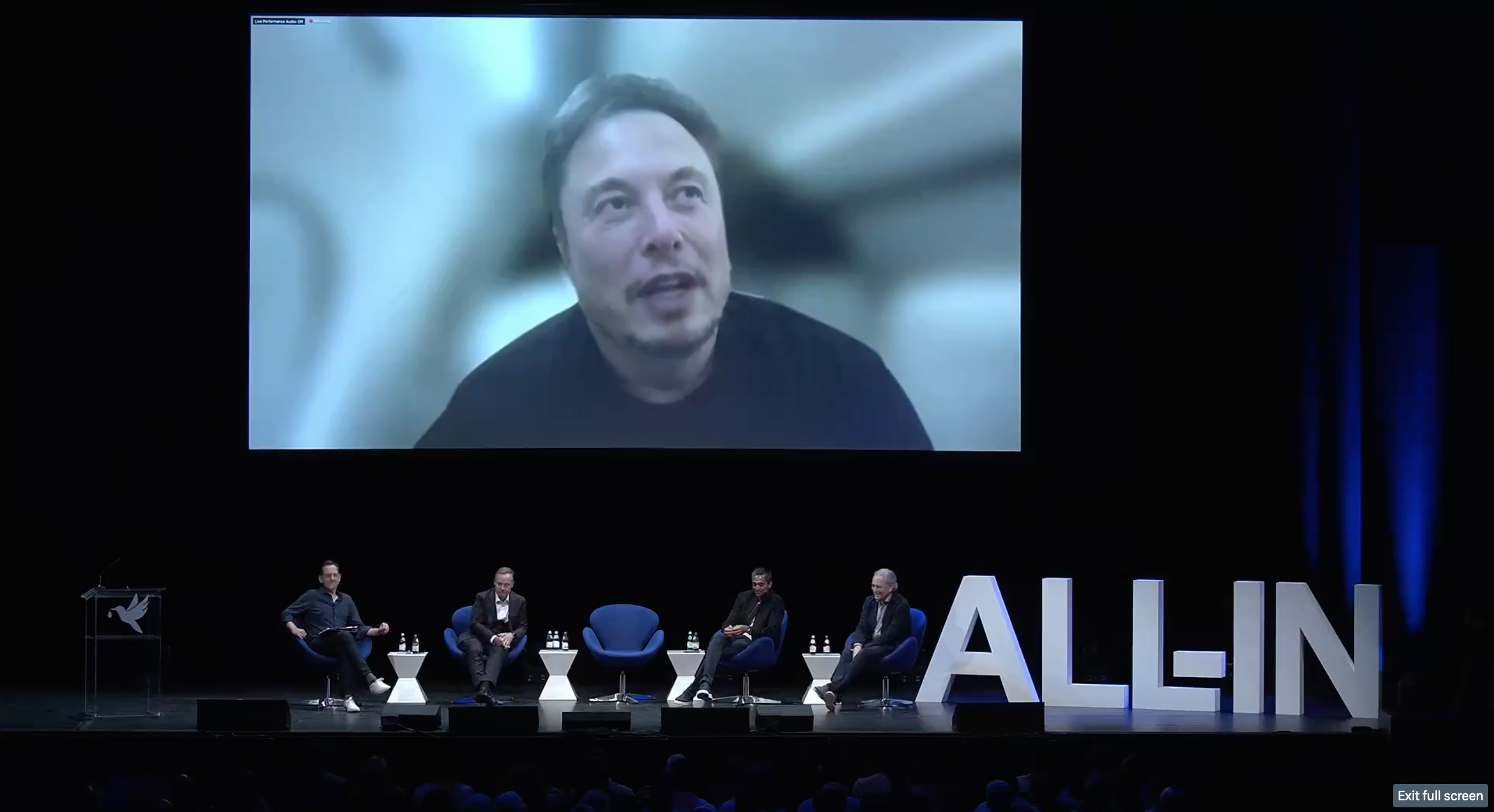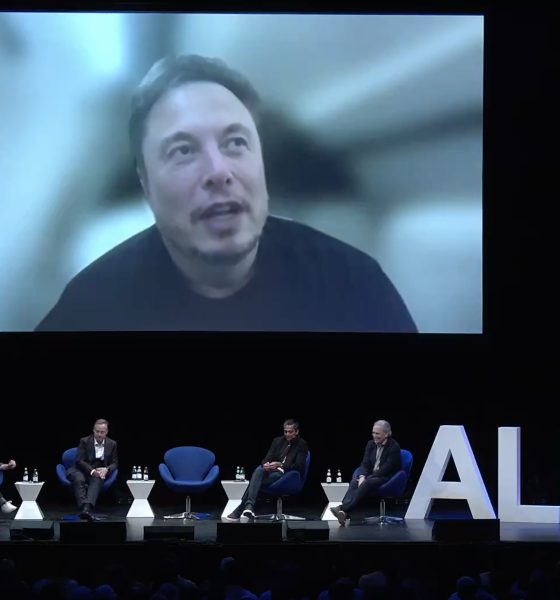During a conference this week, Tesla CEO Elon Musk reiterated claims that the Full Self-Driving (FSD) beta is nearing higher levels of autonomy. The statements echo recent details learned from previews of a new Musk biography, highlighting the FSD system’s many developments in the last several months alone.
Musk was featured in an interview during the All-In Podcast’s 2023 Summit held on Wednesday, during which he discussed topics like Starlink, X, China, artificial intelligence, and more. Among the topics covered was a brief outro on the FSD beta, which he says is “very close” to becoming safer than a human driver without being monitored.
“Yeah, I think it’s getting very close to being in a situation where, even if there’s no human oversight or intervention, that the probability of a safe journey is higher with FSD and no supervision — like even if you’re asleep in the car — than if a person is driving. We’re very close to that,” Musk said on a video call into the summit.
He also pointed to how much the current version of FSD has improved compared to versions from six months ago, a year ago, and 18 months ago. In that time, Musk explained, Tesla has arrived at what it calls the “final piece of the puzzle,” as the company shifts toward making the whole FSD neural network-based.
“And we’ve got the final piece of the puzzle, which is to have the control part of the car transition from about 300,000 lines of C++ code to a [full-scale] neural network, so the whole system will be neural network, photons into controls out,” Musk added.
During the interview, Musk also referred to miles being driven with FSD as being “much safer” than those without it, emphasizing how close the automaker is to solving that “final piece of the puzzle.”
You can watch Musk’s full interview at the 2023 All-In Summit on X, with the FSD discussion taking place around 44:30.
first video from the @allinsummit – in conversation with @elonmusk
available exclusively on @X
(0:00) Besties welcome Elon via Starlink
(05:31) Ukraine and Starlink
(19:10) green shoots of @X
(22:24) the creator economy and optimizing the @x experience
(26:43) the ADL,… pic.twitter.com/vRpnrz3DLV— The All-In Podcast (@theallinpod) September 12, 2023
Tesla Safety Statistics
Tesla releases a regular vehicle safety report detailing quarterly crash results from its Autopilot and FSD systems.
The most recent entry occurred in the fourth quarter of last year, showing fewer crashes when Autopilot technology is engaged than when it isn’t. According to the report, the latest data from the National Highway Traffic Safety Administration (NHTSA) shows that there is an automobile crash in the U.S. every 652,000 miles.
Comparatively, Tesla recorded one crash for every 4.85 million miles driven in Q4 for drivers using its Autopilot systems. Tesla also recorded one crash for every 1.40 million miles driven by drivers in its cars who were not using either of the systems.
The concept of FSD switching to an entirely neural-network-based approach was also detailed earlier this week in previews of a Musk biography written by Walter Isaacson. The biography was published on Wednesday, and it specifically discusses Tesla’s upcoming FSD version 12.
In the past, Musk has said that FSD v12 will no longer be a beta version of the software and will include a significant leap forward.
What are your thoughts? Let me know at zach@teslarati.com, find me on X at @zacharyvisconti, or send your tips to us at tips@teslarati.com.

News
Tesla aims to combat common Full Self-Driving problem with new patent
Tesla writes in the patent that its autonomous and semi-autonomous vehicles are heavily reliant on camera systems to navigate and interact with their environment.

Tesla is aiming to combat a common Full Self-Driving problem with a new patent.
One issue with Tesla’s vision-based approach is that sunlight glare can become a troublesome element of everyday travel. Full Self-Driving is certainly an amazing technology, but there are still things Tesla is aiming to figure out with its development.
Unfortunately, it is extremely difficult to get around this issue, and even humans need ways to combat it when they’re driving, as we commonly use sunglasses or sun visors to give us better visibility.
Cameras obviously do not have these ways to fight sunglare, but a new patent Tesla recently had published aims to fight this through a “glare shield.”
Tesla writes in the patent that its autonomous and semi-autonomous vehicles are heavily reliant on camera systems to navigate and interact with their environment.

The ability to see surroundings is crucial for accurate performance, and glare is one element of interference that has yet to be confronted.
Tesla described the patent, which will utilize “a textured surface composed of an array of micro-cones, or cone-shaped formations, which serve to scatter incident light in various directions, thereby reducing glare and improving camera vision.”

The patent was first spotted by Not a Tesla App.
The design of the micro-cones is the first element of the puzzle to fight the excess glare. The patent says they are “optimized in size, angle, and orientation to minimize Total Hemispherical Reflectance (THR) and reflection penalty, enhancing the camera’s ability to accurately interpret visual data.”
Additionally, there is an electromechanical system for dynamic orientation adjustment, which will allow the micro-cones to move based on the angle of external light sources.
This is not the only thing Tesla is mulling to resolve issues with sunlight glare, as it has also worked on two other ways to combat the problem. One thing the company has discussed is a direct photon count.
CEO Elon Musk said during the Q2 Earnings Call:
“We use an approach which is direct photon count. When you see a processed image, so the image that goes from the sort of photon counter — the silicon photon counter — that then goes through a digital signal processor or image signal processor, that’s normally what happens. And then the image that you see looks all washed out, because if you point the camera at the sun, the post-processing of the photon counting washes things out.”
Future Hardware iterations, like Hardware 5 and Hardware 6, could also integrate better solutions for the sunglare issue, such as neutral density filters or heated lenses, aiming to solve glare more effectively.
Elon Musk
Delaware Supreme Court reinstates Elon Musk’s 2018 Tesla CEO pay package
The unanimous decision criticized the prior total rescission as “improper and inequitable,” arguing that it left Musk uncompensated for six years of transformative leadership at Tesla.

The Delaware Supreme Court has overturned a lower court ruling, reinstating Elon Musk’s 2018 compensation package originally valued at $56 billion but now worth approximately $139 billion due to Tesla’s soaring stock price.
The unanimous decision criticized the prior total rescission as “improper and inequitable,” arguing that it left Musk uncompensated for six years of transformative leadership at Tesla. Musk quickly celebrated the outcome on X, stating that he felt “vindicated.” He also shared his gratitude to TSLA shareholders.
Delaware Supreme Court makes a decision
In a 49-page ruling Friday, the Delaware Supreme Court reversed Chancellor Kathaleen McCormick’s 2024 decision that voided the 2018 package over alleged board conflicts and inadequate shareholder disclosures. The high court acknowledged varying views on liability but agreed rescission was excessive, stating it “leaves Musk uncompensated for his time and efforts over a period of six years.”
The 2018 plan granted Musk options on about 304 million shares upon hitting aggressive milestones, all of which were achieved ahead of time. Shareholders overwhelmingly approved it initially in 2018 and ratified it once again in 2024 after the Delaware lower court struck it down. The case against Musk’s 2018 pay package was filed by plaintiff Richard Tornetta, who held just nine shares when the compensation plan was approved.
A hard-fought victory
As noted in a Reuters report, Tesla’s win avoids a potential $26 billion earnings hit from replacing the award at current prices. Tesla, now Texas-incorporated, had hedged with interim plans, including a November 2025 shareholder-approved package potentially worth $878 billion tied to Robotaxi and Optimus goals and other extremely aggressive operational milestones.
The saga surrounding Elon Musk’s 2018 pay package ultimately damaged Delaware’s corporate appeal, prompting a number of high-profile firms, such as Dropbox, Roblox, Trade Desk, and Coinbase, to follow Tesla’s exodus out of the state. What added more fuel to the issue was the fact that Tornetta’s legal team, following the lower court’s 2024 decision, demanded a fee request of more than $5.1 billion worth of TSLA stock, which was equal to an hourly rate of over $200,000.
Delaware Supreme Court Elon Musk 2018 Pay Package by Simon Alvarez
News
Tesla Cybercab tests are going on overdrive with production-ready units
Tesla is ramping its real-world tests of the Cybercab, with multiple sightings of the vehicle being reported across social media this week.

Tesla is ramping its real-world tests of the Cybercab, with multiple sightings of the autonomous two-seater being reported across social media this week. Based on videos of the vehicle that have been shared online, it appears that Cybercab tests are underway across multiple states.
Recent Cybercab sightings
Reports of Cybercab tests have ramped this week, with a vehicle that looked like a production-ready prototype being spotted at Apple’s Visitor Center in California. The vehicle in this sighting was interesting as it was equipped with a steering wheel. The vehicle also featured some changes to the design of its brake lights.
The Cybercab was also filmed testing at the Fremont factory’s test track, which also seemed to involve a vehicle that looked production-ready. This also seemed to be the case for a Cybercab that was spotted in Austin, Texas, which happened to be undergoing real-world tests. Overall, these sightings suggest that Cybercab testing is fully underway, and the vehicle is really moving towards production.
Production design all but finalized?
Recently, a near-production-ready Cybercab was showcased at Tesla’s Santana Row showroom in San Jose. The vehicle was equipped with frameless windows, dual windshield wipers, powered butterfly door struts, an extended front splitter, an updated lightbar, new wheel covers, and a license plate bracket. Interior updates include redesigned dash/door panels, refined seats with center cupholders, updated carpet, and what appeared to be improved legroom.
There seems to be a pretty good chance that the Cybercab’s design has been all but finalized, at least considering Elon Musk’s comments at the 2025 Annual Shareholder Meeting. During the event, Musk confirmed that the vehicle will enter production around April 2026, and its production targets will be quite ambitious.










